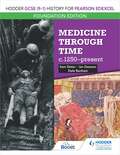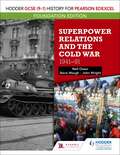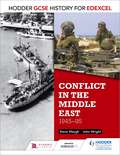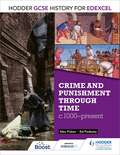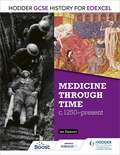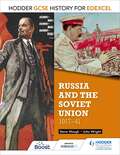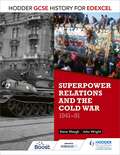- Table View
- List View
Hodder GCSE (9–1) History for Pearson Edexcel Foundation Edition: Medicine through time c.1250–present
by Sam SlaterHelp more students access the content for Pearson Edexcel GCSE History with this Foundation Edition, containing bespoke text and activities to support students working up to Grade 5.Covering Medicine in Britain, c1250-present and the British sector of the Western Front, 1914-18, this book:- Follows the same structure and page numbers as the mainstream textbook for effective co-teaching in the same class- Simplifies and reduces the text on each page, focusing on the essential knowledge that students need- Uses carefully-controlled vocabulary throughout, ensuring that the reading level is appropriate for all students, including those with lower literacy levels or English as an additional language (EAL)- Develops students' knowledge, understanding and skills through accessible and achievable tasks- Provides step-by-step guidance on how to answer exam questions and target a Grade 5, building students' confidence as they revise and practise for their exams
Hodder GCSE (9–1) History for Pearson Edexcel Foundation Edition: Medicine through time c.1250–present
by Sam SlaterHelp more students access the content for Pearson Edexcel GCSE History with this Foundation Edition, containing bespoke text and activities to support students working up to Grade 5.Covering Medicine in Britain, c1250-present and the British sector of the Western Front, 1914-18, this book:- Follows the same structure and page numbers as the mainstream textbook for effective co-teaching in the same class- Simplifies and reduces the text on each page, focusing on the essential knowledge that students need- Uses carefully-controlled vocabulary throughout, ensuring that the reading level is appropriate for all students, including those with lower literacy levels or English as an additional language (EAL)- Develops students' knowledge, understanding and skills through accessible and achievable tasks- Provides step-by-step guidance on how to answer exam questions and target a Grade 5, building students' confidence as they revise and practise for their exams
Hodder GCSE (9–1) History for Pearson Edexcel Foundation Edition: Superpower Relations and the Cold War 1941–91
by John Wright Steve Waugh Neil OwenExam board: Pearson EdexcelLevel: GCSE (9-1)Subject: HistoryFirst teaching: September 2016First exams: Summer 2018Help more students access the content for Pearson Edexcel GCSE History with this Foundation Edition, containing bespoke text and activities to support students working up to Grade 5.Covering Superpower relations and the Cold War, 1941-91, this book:- Follows the same structure and page numbers as the mainstream textbook for effective co-teaching in the same class- Simplifies and reduces the text on each page, focusing on the essential knowledge that students need and using clear diagrams to explain more challenging concepts- Uses carefully-controlled vocabulary throughout, ensuring that the reading level is appropriate for all students, including those with lower literacy levels or English as an additional language (EAL)- Develops students' knowledge, understanding and skills through accessible and achievable tasks- Provides step-by-step guidance on how to answer exam questions and target a Grade 5, building students' confidence as they revise and practise for their exams- Includes definitions of 'useful words' and 'history words' at the start of each key topic to boost students' vocabulary
Hodder GCSE (9–1) History for Pearson Edexcel Foundation Edition: Superpower Relations and the Cold War 1941–91
by John Wright Steve Waugh Neil OwenExam board: Pearson EdexcelLevel: GCSE (9-1)Subject: HistoryFirst teaching: September 2016First exams: Summer 2018Help more students access the content for Pearson Edexcel GCSE History with this Foundation Edition, containing bespoke text and activities to support students working up to Grade 5.Covering Superpower relations and the Cold War, 1941-91, this book:- Follows the same structure and page numbers as the mainstream textbook for effective co-teaching in the same class- Simplifies and reduces the text on each page, focusing on the essential knowledge that students need and using clear diagrams to explain more challenging concepts- Uses carefully-controlled vocabulary throughout, ensuring that the reading level is appropriate for all students, including those with lower literacy levels or English as an additional language (EAL)- Develops students' knowledge, understanding and skills through accessible and achievable tasks- Provides step-by-step guidance on how to answer exam questions and target a Grade 5, building students' confidence as they revise and practise for their exams- Includes definitions of 'useful words' and 'history words' at the start of each key topic to boost students' vocabulary
Hodder GCSE (9–1) History for Pearson Edexcel Foundation Edition: Weimar and Nazi Germany, 1918–39
by Benjamin ArmstrongExam board: Pearson EdexcelLevel: GCSE (9-1)Subject: HistoryFirst teaching: September 2016First exams: Summer 2018Help more students access the content for Pearson Edexcel GCSE History with this Foundation Edition, containing bespoke text and activities to support students working up to Grade 5.Covering Weimar and Nazi Germany, 1918-39, this book:- Follows the same structure and page numbers as the mainstream textbook for effective co-teaching in the same class- Simplifies and reduces the text on each page, focusing on the essential knowledge that students need and using clear diagrams to explain more challenging concepts- Uses carefully-controlled vocabulary throughout, ensuring that the reading level is appropriate for all students, including those with lower literacy levels or English as an additional language (EAL)- Develops students' knowledge, understanding and skills through accessible and achievable tasks- Provides step-by-step guidance on how to answer exam questions and target a Grade 5, building students' confidence as they revise and practise for their exams- Includes definitions of 'useful words' and 'history words' at the start of each key topic to boost students' vocabularyReading level measured and verified by MetaMetrics using the Lexile Framework for Reading
Hodder GCSE (9–1) History for Pearson Edexcel Foundation Edition: Weimar and Nazi Germany, 1918–39
by Benjamin ArmstrongExam board: Pearson EdexcelLevel: GCSE (9-1)Subject: HistoryFirst teaching: September 2016First exams: Summer 2018Help more students access the content for Pearson Edexcel GCSE History with this Foundation Edition, containing bespoke text and activities to support students working up to Grade 5.Covering Weimar and Nazi Germany, 1918-39, this book:- Follows the same structure and page numbers as the mainstream textbook for effective co-teaching in the same class- Simplifies and reduces the text on each page, focusing on the essential knowledge that students need and using clear diagrams to explain more challenging concepts- Uses carefully-controlled vocabulary throughout, ensuring that the reading level is appropriate for all students, including those with lower literacy levels or English as an additional language (EAL)- Develops students' knowledge, understanding and skills through accessible and achievable tasks- Provides step-by-step guidance on how to answer exam questions and target a Grade 5, building students' confidence as they revise and practise for their exams- Includes definitions of 'useful words' and 'history words' at the start of each key topic to boost students' vocabularyReading level measured and verified by MetaMetrics using the Lexile Framework for Reading
Hodder GCSE (9–1) History for Pearson Edexcel: Migrants in Britain, c800–present and Notting Hill c1948–c1970
by Abdul Mohamud Robin WhitburnExam board: Pearson EdexcelLevel: GCSE (9-1)Subject: HistoryFirst teaching: September 2021First exam: Summer 2022Endorsed for Pearson Edexcel qualificationsLet Justice to History - one of the most respected organisations in the teaching community - guide you through the themes, events and stories within this hugely important topic.Every page of this book is informed by meticulous research, motivated by a deep commitment to representative history and inspired by years of transformative work with students and teachers.> Understand changes over time. Each period from the specification begins with a Migration Highway double-page spread that illustrates the key people, dates and turning points. Together, the Highways develop the 'big story' of migration.> Follow an enquiry-based approach. An overarching enquiry question for each chapter structures students' thinking and information gathering. Students then apply their learning to an end-of-chapter exam-style question.> Build historical skills and knowledge. Comprehension and source questions throughout the book develop conceptual understanding and students' ability to explain, analyse, evaluate and make judgements.> Bring the historic environment to life. A rich collection of sources enables students to explore the events and developments in Notting Hill - an area of particular expertise for the authors.> Prepare for exam success. A dedicated chapter on Writing Better History provides step-by-step guidance for answering each question type effectively.
Hodder GCSE (9–1) History for Pearson Edexcel: Migrants in Britain, c800–present and Notting Hill c1948–c1970
by Abdul Mohamud Robin WhitburnExam board: Pearson EdexcelLevel: GCSE (9-1)Subject: HistoryFirst teaching: September 2021First exam: Summer 2022Endorsed for Pearson Edexcel qualificationsLet Justice to History - one of the most respected organisations in the teaching community - guide you through the themes, events and stories within this hugely important topic.Every page of this book is informed by meticulous research, motivated by a deep commitment to representative history and inspired by years of transformative work with students and teachers.> Understand changes over time. Each period from the specification begins with a Migration Highway double-page spread that illustrates the key people, dates and turning points. Together, the Highways develop the 'big story' of migration.> Follow an enquiry-based approach. An overarching enquiry question for each chapter structures students' thinking and information gathering. Students then apply their learning to an end-of-chapter exam-style question.> Build historical skills and knowledge. Comprehension and source questions throughout the book develop conceptual understanding and students' ability to explain, analyse, evaluate and make judgements.> Bring the historic environment to life. A rich collection of sources enables students to explore the events and developments in Notting Hill - an area of particular expertise for the authors.> Prepare for exam success. A dedicated chapter on Writing Better History provides step-by-step guidance for answering each question type effectively.
Hodder GCSE History for Edexcel: Anglo-Saxon and Norman England, c106088
by Ian Dawson Esther Arnott Libby MerrittEndorsed for EdexcelHelp your students achieve their full potential while ensuring pace, enjoyment and motivation with this unique series from the leading History publisher; developed by expert educators who know how to instil deep subject knowledge and an appetite for lifelong learning.- Provides distinct approaches to the different components of the 2016 specification, ensuring that your classroom resources are tailored to learners' changing needs as they progress through the curriculum- Caters for varying learning styles, using an exciting mix of clear narrative, visual stimulus materials and a rich collection of contemporary sources to capture the interest of all students- Helps students maximise their grade potential and develop their exam skills through structured guidance on answering every question type successfully- Blends in-depth coverage of topics with activities and strategies to help students acquire, retain and revise core subject knowledge across the years- Builds on our experience publishing popular GCSE resources to supply you with accurate, authoritative content written by experienced teachers who understand the practical implications of new content and assessment requirementsAnglo-Saxon and Norman England, c.1066-88 covers all three key topics in the specification: 'Anglo-Saxon England and the Norman Conquest, 1060-66'; 'William in power: securing the kingdom, 1066-87'; 'Norman England, 1066-88.'
Hodder GCSE History for Edexcel: Anglo-Saxon and Norman England, c1060–88
by Ian Dawson Esther Arnott Libby MerrittExam Board: Pearson EdexcelLevel: GCSESubject: HistoryFirst teaching: September 2016First exams: June 2018Endorsed for EdexcelEnable students to achieve their full potential while ensuring pace, enjoyment and motivation with this popular series from the leading History publisher for secondary schools.> Blends in-depth coverage of topics with activities and strategies to help students to acquire, retain and revise core subject knowledge > Uses an exciting mix of clear narrative, visual stimulus materials and a rich collection of contemporary sources to capture students' interest> Helps students to maximise their grade potential and develop their exam skills through structured guidance on answering every question type successfully> Builds on our experience publishing popular GCSE History resources, providing you with accurate, authoritative content written by experienced teachers who understand the content and assessment requirementsAnglo-Saxon and Norman England, c.1066-88 covers all three key topics in the specification: 'Anglo-Saxon England and the Norman Conquest, 1060-66'; 'William in power: securing the kingdom, 1066-87'; 'Norman England, 1066-88.'
Hodder GCSE History for Edexcel: Conflict in the Middle East, 1945-95
by John Wright Steve WaughEndorsed for EdexcelHelp your students achieve their full potential while ensuring pace, enjoyment and motivation with this unique series from the leading History publisher; developed by expert educators who know how to instil deep subject knowledge and an appetite for lifelong learning.- Provides distinct approaches to the different components of the 2016 specification, ensuring that your classroom resources are tailored to learners' changing needs as they progress through the curriculum- Caters for varying learning styles, using an exciting mix of clear narrative, visual stimulus materials and a rich collection of contemporary sources to capture the interest of all students- Helps students maximise their grade potential and develop their exam skills through structured guidance on answering every question type successfully- Blends in-depth coverage of topics with activities and strategies to help students acquire, retain and revise core subject knowledge across the years- Builds on our experience publishing popular GCSE resources to supply you with accurate, authoritative content written by experienced teachers who understand the practical implications of new content and assessment requirementsConflict in the Middle East, 1945-95 covers all three key topics in the specification: 'The birth of the state of Israel, 1945-63'; 'The escalating conflict, 1964-73'; 'Attempts at a solution, 1974-95'
Hodder GCSE History for Edexcel: Crime and punishment through time, c1000-present
by Alec Fisher Ed PodestaEndorsed for EdexcelExam board: Pearson EdexcelLevel: GCSESubject: HistoryFirst teaching: September 2016First exams: Summer 2018Enable students to achieve their full potential while ensuring pace, enjoyment and motivation with this popular series from the leading History publisher for secondary schools.> Blends in-depth coverage of topics with activities and strategies to help students to acquire, retain and revise core subject knowledge > Uses an exciting mix of clear narrative, visual stimulus materials and a rich collection of contemporary sources to capture students' interest> Helps students to maximise their grade potential and develop their exam skills through structured guidance on answering every question type successfully> Builds on our experience publishing popular GCSE History resources, providing you with accurate, authoritative content written by experienced teachers who understand the content and assessment requirementsCrime and punishment through time, c.1000-present covers both the thematic study 'Crime and punishment in Britain, c.1000-present' and the study of the historic environment 'Whitechapel, c.1870-c.1900: crime, policing and the inner city.'
Hodder GCSE History for Edexcel: Early Elizabethan England, 155888
by Barbara MervynEndorsed for EdexcelHelp your students achieve their full potential while ensuring pace, enjoyment and motivation with this unique series from the leading History publisher; developed by expert educators who know how to instil deep subject knowledge and an appetite for lifelong learning.- Provides distinct approaches to the different components of the 2016 specification, ensuring that your classroom resources are tailored to learners' changing needs as they progress through the curriculum- Caters for varying learning styles, using an exciting mix of clear narrative, visual stimulus materials and a rich collection of contemporary sources to capture the interest of all students- Helps students maximise their grade potential and develop their exam skills through structured guidance on answering every question type successfully- Blends in-depth coverage of topics with activities and strategies to help students acquire, retain and revise core subject knowledge across the years- Builds on our experience publishing popular GCSE resources to supply you with accurate, authoritative content written by experienced teachers who understand the practical implications of new content and assessment requirementsEarly Elizabethan England, 1558-88 covers all three key topics in the specification: 'Queen, government and religion, 1558-69'; 'Challenges to Elizabeth at home and abroad, 1569-88'; 'Elizabethan society in the Age of Exploration, 1558-88.'
Hodder GCSE History for Edexcel: Early Elizabethan England, 1558–88
by Barbara MervynExam Board: Pearson EdexcelLevel: GCSESubject: HistoryFirst teaching: September 2016First exams: June 2018Endorsed for EdexcelEnable students to achieve their full potential while ensuring pace, enjoyment and motivation with this popular series from the leading History publisher for secondary schools.> Blends in-depth coverage of topics with activities and strategies to help students to acquire, retain and revise core subject knowledge > Uses an exciting mix of clear narrative, visual stimulus materials and a rich collection of contemporary sources to capture students' interest> Helps students to maximise their grade potential and develop their exam skills through structured guidance on answering every question type successfully> Builds on our experience publishing popular GCSE History resources, providing you with accurate, authoritative content written by experienced teachers who understand the content and assessment requirementsEarly Elizabethan England, 1558-88 covers all three key topics in the specification: 'Queen, government and religion, 1558-69'; 'Challenges to Elizabeth at home and abroad, 1569-88'; 'Elizabethan society in the Age of Exploration, 1558-88.'
Hodder GCSE History for Edexcel: Early Elizabethan England, 1558–88 (Hodder Gcse History For Edexcel Ser.)
by Barbara MervynExam Board: Pearson EdexcelLevel: GCSESubject: HistoryFirst teaching: September 2016First exams: June 2018Endorsed for EdexcelEnable students to achieve their full potential while ensuring pace, enjoyment and motivation with this popular series from the leading History publisher for secondary schools.> Blends in-depth coverage of topics with activities and strategies to help students to acquire, retain and revise core subject knowledge > Uses an exciting mix of clear narrative, visual stimulus materials and a rich collection of contemporary sources to capture students' interest> Helps students to maximise their grade potential and develop their exam skills through structured guidance on answering every question type successfully> Builds on our experience publishing popular GCSE History resources, providing you with accurate, authoritative content written by experienced teachers who understand the content and assessment requirementsEarly Elizabethan England, 1558-88 covers all three key topics in the specification: 'Queen, government and religion, 1558-69'; 'Challenges to Elizabeth at home and abroad, 1569-88'; 'Elizabethan society in the Age of Exploration, 1558-88.'
Hodder GCSE History for Edexcel: Henry VIII and his ministers, 150940
by Dale Scarboro Ian DawsonEndorsed for EdexcelHelp your students achieve their full potential while ensuring pace, enjoyment and motivation with this unique series from the leading History publisher; developed by expert educators who know how to instil deep subject knowledge and an appetite for lifelong learning.- Provides distinct approaches to the different components of the 2016 specification, ensuring that your classroom resources are tailored to learners' changing needs as they progress through the curriculum- Caters for varying learning styles, using an exciting mix of clear narrative, visual stimulus materials and a rich collection of contemporary sources to capture the interest of all students- Helps students maximise their grade potential and develop their exam skills through structured guidance on answering every question type successfully- Blends in-depth coverage of topics with activities and strategies to help students acquire, retain and revise core subject knowledge across the years- Builds on our experience publishing popular GCSE resources to supply you with accurate, authoritative content written by experienced teachers who understand the practical implications of new content and assessment requirementsHenry VIII and his ministers, 1509-40 covers all three key topics in the specification: 'Henry VIII and Wolsey, 1509-29'; 'Henry VIII and Cromwell, 1529-40'; 'The Reformation and its impact, 1529-40.'
Hodder GCSE History for Edexcel: Henry VIII and his ministers, 1509–40
by Dale Scarboro Ian DawsonExam Board: Pearson EdexcelLevel: GCSESubject: HistoryFirst teaching: September 2016First exams: June 2018Endorsed for EdexcelEnable students to achieve their full potential while ensuring pace, enjoyment and motivation with this popular series from the leading History publisher for secondary schools.> Blends in-depth coverage of topics with activities and strategies to help students to acquire, retain and revise core subject knowledge > Uses an exciting mix of clear narrative, visual stimulus materials and a rich collection of contemporary sources to capture students' interest> Helps students to maximise their grade potential and develop their exam skills through structured guidance on answering every question type successfully> Builds on our experience publishing popular GCSE History resources, providing you with accurate, authoritative content written by experienced teachers who understand the content and assessment requirementsHenry VIII and his ministers, 1509-40 covers all three key topics in the specification: 'Henry VIII and Wolsey, 1509-29'; 'Henry VIII and Cromwell, 1529-40'; 'The Reformation and its impact, 1529-40.'
Hodder GCSE History for Edexcel: Medicine Through Time (Hodder Gcse History For Edexcel Ser.)
by Ian DawsonExam Board: Pearson EdexcelLevel: GCSESubject: HistoryFirst teaching: September 2016First exams: June 2018Endorsed for EdexcelEnable students to achieve their full potential while ensuring pace, enjoyment and motivation with this popular series from the leading History publisher for secondary schools.> Blends in-depth coverage of topics with activities and strategies to help students to acquire, retain and revise core subject knowledge > Uses an exciting mix of clear narrative, visual stimulus materials and a rich collection of contemporary sources to capture students' interest> Helps students to maximise their grade potential and develop their exam skills through structured guidance on answering every question type successfully> Builds on our experience publishing popular GCSE History resources, providing you with accurate, authoritative content written by experienced teachers who understand the content and assessment requirementsMedicine through time c.1250-present covers both the thematic study 'Medicine in Britain, c.1250-present' and the study of the historic environment 'The British sector of the Western Front, 1914-18: injuries, treatment and the trenches.'
Hodder GCSE History for Edexcel: Medicine through time, c1250present
by Ian DawsonEndorsed for EdexcelHelp your students achieve their full potential while ensuring pace, enjoyment and motivation with this unique series from the leading History publisher; developed by expert educators who know how to instil deep subject knowledge and an appetite for lifelong learning.- Provides distinct approaches to the different components of the 2016 specification, ensuring that your classroom resources are tailored to learners' changing needs as they progress through the curriculum- Caters for varying learning styles, using an exciting mix of clear narrative, visual stimulus materials and a rich collection of contemporary sources to capture the interest of all students- Helps students maximise their grade potential and develop their exam skills through structured guidance on answering every question type successfully- Blends in-depth coverage of topics with activities and strategies to help students acquire, retain and revise core subject knowledge across the years- Builds on our experience publishing popular GCSE resources to supply you with accurate, authoritative content written by experienced teachers who understand the practical implications of new content and assessment requirementsMedicine through time c.1250-present covers both the thematic study 'Medicine in Britain, c.1250-present' and the study of the historic environment 'The British sector of the Western Front, 1914-18: injuries, treatment and the trenches.'
Hodder GCSE History for Edexcel: Reigns Of Richard I And John
by Dale BanhamExam Board: Pearson EdexcelLevel: GCSESubject: HistoryFirst teaching: September 2016First exams: June 2018Endorsed for EdexcelEnable students to achieve their full potential while ensuring pace, enjoyment and motivation with this popular series from the leading History publisher for secondary schools.> Blends in-depth coverage of topics with activities and strategies to help students to acquire, retain and revise core subject knowledge > Uses an exciting mix of clear narrative, visual stimulus materials and a rich collection of contemporary sources to capture students' interest> Helps students to maximise their grade potential and develop their exam skills through structured guidance on answering every question type successfully> Builds on our experience publishing popular GCSE History resources, providing you with accurate, authoritative content written by experienced teachers who understand the content and assessment requirementsThe reigns of King Richard I and King John, 1189-1216 covers all three key topics in the specification: 'Life and government in England, 1189-1216'; 'Involvement overseas, 1189-1204'; 'King John's downfall, 1205-16.'
Hodder GCSE History for Edexcel: Reigns Of Richard I And John (Hodder Gcse History For Edexcel Ser.)
by Dale BanhamExam Board: Pearson EdexcelLevel: GCSESubject: HistoryFirst teaching: September 2016First exams: June 2018Endorsed for EdexcelEnable students to achieve their full potential while ensuring pace, enjoyment and motivation with this popular series from the leading History publisher for secondary schools.> Blends in-depth coverage of topics with activities and strategies to help students to acquire, retain and revise core subject knowledge > Uses an exciting mix of clear narrative, visual stimulus materials and a rich collection of contemporary sources to capture students' interest> Helps students to maximise their grade potential and develop their exam skills through structured guidance on answering every question type successfully> Builds on our experience publishing popular GCSE History resources, providing you with accurate, authoritative content written by experienced teachers who understand the content and assessment requirementsThe reigns of King Richard I and King John, 1189-1216 covers all three key topics in the specification: 'Life and government in England, 1189-1216'; 'Involvement overseas, 1189-1204'; 'King John's downfall, 1205-16.'
Hodder GCSE History for Edexcel: Russia And The Soviet Union (Hodder Gcse History For Edexcel Ser.)
by John Wright Steve WaughExam Board: Pearson EdexcelLevel: GCSESubject: HistoryFirst teaching: September 2016First exams: June 2018Endorsed for EdexcelEnable students to achieve their full potential while ensuring pace, enjoyment and motivation with this popular series from the leading History publisher for secondary schools.> Blends in-depth coverage of topics with activities and strategies to help students to acquire, retain and revise core subject knowledge > Uses an exciting mix of clear narrative, visual stimulus materials and a rich collection of contemporary sources to capture students' interest> Helps students to maximise their grade potential and develop their exam skills through structured guidance on answering every question type successfully> Builds on our experience publishing popular GCSE History resources, providing you with accurate, authoritative content written by experienced teachers who understand the content and assessment requirementsRussia and the Soviet Union, 1917-41 covers all four key topics in the specification: 'The revolutions of 1917'; 'The Bolsheviks in power, 1917-24'; 'Stalin's rise to power and dictatorship, 1924-41'; 'Economic and social changes, 1924-41.'
Hodder GCSE History for Edexcel: Russia and the Soviet Union, 1917-41
by John Wright Steve WaughEndorsed for EdexcelHelp your students achieve their full potential while ensuring pace, enjoyment and motivation with this unique series from the leading History publisher; developed by expert educators who know how to instil deep subject knowledge and an appetite for lifelong learning.- Provides distinct approaches to the different components of the 2016 specification, ensuring that your classroom resources are tailored to learners' changing needs as they progress through the curriculum- Caters for varying learning styles, using an exciting mix of clear narrative, visual stimulus materials and a rich collection of contemporary sources to capture the interest of all students- Helps students maximise their grade potential and develop their exam skills through structured guidance on answering every question type successfully- Blends in-depth coverage of topics with activities and strategies to help students acquire, retain and revise core subject knowledge across the years- Builds on our experience publishing popular GCSE resources to supply you with accurate, authoritative content written by experienced teachers who understand the practical implications of new content and assessment requirementsRussia and the Soviet Union, 1917-41 covers all four key topics in the specification: 'The revolutions of 1917'; 'The Bolsheviks in power, 1917-24'; 'Stalin's rise to power and dictatorship, 1924-41'; 'Economic and social changes, 1924-41.'
Hodder GCSE History for Edexcel: Superpower relations and the Cold War, 1941-91
by John Wright Steve WaughExam Board: Pearson EdexcelLevel: GCSESubject: HistoryFirst teaching: September 2016First exams: June 2018Endorsed for EdexcelEnable students to achieve their full potential while ensuring pace, enjoyment and motivation with this popular series from the leading History publisher for secondary schools.> Blends in-depth coverage of topics with activities and strategies to help students to acquire, retain and revise core subject knowledge > Uses an exciting mix of clear narrative, visual stimulus materials and a rich collection of contemporary sources to capture students' interest> Helps students to maximise their grade potential and develop their exam skills through structured guidance on answering every question type successfully> Builds on our experience publishing popular GCSE History resources, providing you with accurate, authoritative content written by experienced teachers who understand the content and assessment requirementsSuperpower relations and the Cold War, 1941-91 covers all three key topics in the specification: 'The origins of the Cold War 1941-58'; 'Cold War crises, 1958-70'; 'The end of the Cold War, 1970-91.'
Hodder GCSE History for Edexcel: Superpower relations and the Cold War, 1941-91
by John Wright Steve WaughEndorsed for EdexcelHelp your students achieve their full potential while ensuring pace, enjoyment and motivation with this unique series from the leading History publisher; developed by expert educators who know how to instil deep subject knowledge and an appetite for lifelong learning.- Provides distinct approaches to the different components of the 2016 specification, ensuring that your classroom resources are tailored to learners' changing needs as they progress through the curriculum- Caters for varying learning styles, using an exciting mix of clear narrative, visual stimulus materials and a rich collection of contemporary sources to capture the interest of all students- Helps students maximise their grade potential and develop their exam skills through structured guidance on answering every question type successfully- Blends in-depth coverage of topics with activities and strategies to help students acquire, retain and revise core subject knowledge across the years- Builds on our experience publishing popular GCSE resources to supply you with accurate, authoritative content written by experienced teachers who understand the practical implications of new content and assessment requirementsSuperpower relations and the Cold War, 1941-91 covers all three key topics in the specification: 'The origins of the Cold War 1941-58'; 'Cold War crises, 1958-70'; 'The end of the Cold War, 1970-91.'
